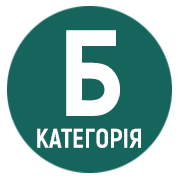INTERMEDIAL CODE OF IHOR KALYNETS LYRIC POETRY
DOI:
https://doi.org/10.32782/2412-933X/2025-XXIV-17Keywords:
yrics, aestheticism, creative self-expression, synesthetic imagery, intermediality, musical code, prison textAbstract
The article proposes interdisciplinary approaches to the interpretation of Ihor Kalynets creative work. The analysis includes a selection of poems from the 1960s–1980s, representative in terms of the presence of literary-artistic correlations. Without losing civic pathos, the poet’s lyricism appears aesthetically complete thanks to the enrichment with visual means of related arts, which formed its intermedial code. The aesthetic and stylistic expediency of the poet’s use of intermedial constructions at various levels of organization of the author’s text is substantiated, the ideological- artistic function of semantic tropes in his visual-expressive system is clarified. The main focus is on identifying the expressive potential of the poet’s poems in the artistic space, the expressive possibilities of the synthesis of word and music, and the ways of their transposition to the verbal level. The research is carried out within the paradigm of intermedial methodology in combination with the resources of biographical and receptive methods of literary studies.As a result of the conducted analysis, the initial assumption is confirmed that the transfer of artistic meta-language of related arts to the verbal level serves to enhance the aesthetic and communicative potential of I. Kalynets lyrics, universalizing his artistic mission. The poet masterfully uses visual attribution from other arts, effectively employs synesthetic tropes for the sacralization of patriotic feelings, the expression of experiences and emotions, the apologetization of national-cultural code artifacts, and the recreation of the existentially conditioned inner world of the individual under conditions of physical unfreedom. Through the prism of the personified musical imagery, I. Kalynets comprehends the spiritual sources of ancestral memory and the mentality of the Ukrainian people.The acoustic-musical accompaniment of the word in his poems enhances its expressive orientation, saturates it emotionally and symbolically, emphasizes the existential influence on the recipient, reveals the multilevel character of the sensory sphere, and forms a synergetic effect at the level of the imagery system and the presented meanings of being. Therefore, the intermedial code of the poet’s lyrics can be considered an important factor in decoding its artistic potential.
References
Віват Г. Інтермедіальність як результат духовного впливу мистецтва на творчу особистість (на матеріалі творчості І. Калинця та В. Стуса). Питання літературознавства. 2008. Вип. 76. С. 117–128.
Гнатюк О. Від упорядника збірки. Калинець І. Пробуджена муза : поезії / упоряд., вступ. ст. О. Гнатюк. Варшава : Об’єднання українців у Польщі : Вид-во Канадського Інституту Українських Студій, 1991. С. 3–27.
Горболіс Л. Міжмистецькі контакти українського тексту : монографія. Суми : Вид-во СумДПУ імені А.С. Макаренка, 2021. 312 с.
Еліот Т. Музика поезії : антологія світової літературно-критичної думки ХХ ст. / за ред. М. Зубрицької. Львів : Літопис, 2001. С. 95–108.
Забужко О. Замість передмови: Дві алогії на калинову тему. Калинець І. Зібрання творів : у 2 т. Київ : Факт, 2004. Т. 1 : Пробуджена муза. С. 5–14.
Ільницький М. Формули осягання Антонича. Львів : ЛА «Піраміда», 2015. 236 с.
Калинець І. Слово триваюче : поезії. Харків : Фоліо, 1997. 542 с.
Лановик М. «А поезія завжди елітарна…» (Роздуми про поезію Ігоря Калинця). URL: https://md-eksperiment.org/post/20170526-a-poeziya-zavzhdi-elitarna-rozdumi-pro-poeziyu-igorya-kalincya (дата звернення: 28.03.2025).
Маланюк Є. Думки про мистецтво. Книга спостережень : статті про літературу. Київ : Дніпро, 1997. С. 74–82.
Мафтин Н. «Знов сниться нації легенда про ностальгійний дар євшану»: Дивосвіт поезії Ігоря Калинця. Дивослово. 2004. № 7. С. 59–63.
Модернізм в українській літературі ХХ – початку ХХІ століття: пам’ять, коди, практики : монографія / відп. ред. Т. Пастух ; НАН України, Інститут українознавства ім. І. Крип’якевича. Львів, 2023. 758 с.
Попова О. Інтермедіальні студії у сучасному літературознавстві. Проблеми семантики слова, речення та тексту : збірник наукових праць. 2017. Вип. 38. С. 163–167.
Просалова В. Інтермедіальні аспекти новітньої української літератури : монографія. Донецьк : ДонНУ, 2015. 154 с.
Просалова В. Інтертекстуальний аналіз: теорія і практика : навчальний посібник. Вінниця : ТВОРИ, 2019. 176 с.
Рисак О. Мелодії і барви слова: Проблеми синтезу мистецтв в українській літературі кінця ХІХ – початку ХХ ст. : монографія. Луцьк : Надстир’я, 1996. 98 с.
Савчук Г. «Пробуджена муза» Ігоря Калинця в інтермистецькому діалозі з Олексою Новаків- ським. Вісник Харківського національного університету імені В.Н. Каразіна. 2024. Вип. 94. С. 19–25.
Салига Т. Його терновий вогонь. Імператив: Літературознавчі статті, критика, публіцистика. Львів : Світ, 1997. С. 204–219.
Світличний І. На калині клином світ зійшовся. URL: https://shron1.chtyvo.org.ua/Svitlychnyi_Ivan/Tvory_poezii_pereklady_publitsystyka.pdf?PHPSESSID=lrdp2erq (дата звернення: 10. 04. 2025).
Соловей Е. У країні Лицарії, країні колядок. Калинець І. Слово триваюче : поезії. Харків : Фоліо, 1997. С. 5–11.
Фрайт О. Музична номеносфера як індикатор емінентності літературних текстів. Актуальні питання гуманітарних наук. 2021. Вип. 45 (2). С. 49–54.
Франко І. Із секретів поетичної творчості. Зібрання творів : у 50-ти т. Київ : Наукова думка, 1981. Т. 31. С. 45–119.
Художньо-меморіальний музей Олекси Новаківського : путівник. Львів : НМЛ ім. А. Шептицького, 2013. 39 с.






